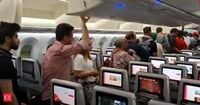More than 200 passengers found themselves in a frustrating limbo at Delhi’s Indira Gandhi International Airport late on September 10, 2025, as a scheduled Air India flight to Singapore was beset by technical troubles that would leave travelers stranded for nearly six hours. What was supposed to be a routine overnight journey on Air India flight AI2380—operated by a Boeing 787-9 Dreamliner—quickly devolved into a test of patience, resilience, and the airline’s crisis management protocols.
According to multiple reports, including coverage from The Economic Times, PTI, and Hindustan Times, the trouble began around 11 pm as passengers boarded the aircraft, anticipating a smooth takeoff. But after settling into their seats, they soon realized something was amiss. The air conditioning system had malfunctioned, causing the cabin temperature to climb uncomfortably high. With the doors left open as per safety protocol and the aircraft parked at the bay, cooling the interior became a losing battle. Social media videos showed passengers fanning themselves with newspapers and magazines, trying to cope with the stifling heat.
“Passengers boarded the flight around 11 pm and remained seated for close to two hours before being asked to deplane,” reported The Economic Times. The airline later confirmed that a “cabin cooling issue on ground prior to departure” was responsible for the ordeal. The discomfort was palpable, and the atmosphere inside the aircraft was tense as travelers—some with young children or elderly family members—waited for updates.
As the minutes ticked by, the decision was made to evacuate the passengers back to the terminal. The process, while necessary, added to the confusion and fatigue. “Passengers were regularly kept informed of the delay and our ground colleagues in Delhi extended all support to passengers at the airport, including providing refreshments and meals,” Air India stated, as quoted by PTI. The airline emphasized that, despite the disruption, basic needs were met and communication was maintained throughout the night.
For many, however, the delay was more than just an inconvenience. Connecting schedules and onward travel plans in Singapore were thrown into disarray, with some travelers expressing concerns about missed meetings, hotel check-ins, or further flights. The incident raised broader questions about operational preparedness and the handling of technical snags on international routes, especially given the increasing reliance on long-haul, wide-body aircraft like the Dreamliner.
By the early hours of September 11, Air India had managed to source a replacement aircraft, a feat not always easily accomplished given the complexities of fleet management and operational schedules. The Singapore-bound service finally departed at 05:36 am IST, nearly six hours behind schedule. “We regret the inconvenience caused to our guests,” the airline said in its official statement, reiterating its commitment to passenger safety and well-being.
Unfortunately, this was not an isolated event for Air India. The airline has faced similar technical snags with its Boeing 787 fleet before. On June 30, 2024, roughly 250 passengers were stranded in Copenhagen, Denmark, after a scheduled flight to Delhi was abruptly canceled due to another Dreamliner malfunction. According to BBC and The Economic Times, families with young children and elderly travelers were left in hostel-style accommodations for days, with some struggling to find suitable food options. Communication lapses and logistical hurdles compounded the stress, as passengers waited for updates and alternative travel arrangements.
In both the Delhi and Copenhagen incidents, Air India cited technical faults—specifically with the air conditioning and electrical systems of the Boeing 787 Dreamliner—as the root cause. The airline’s response included arranging hotel stays, distributing meal vouchers, and providing options for either full refunds or free rescheduling. Yet, for many affected travelers, the experience left a lingering sense of uncertainty about the reliability of long-haul international flights and the adequacy of contingency planning.
Air India’s spokesperson acknowledged the challenges, stating after the Copenhagen disruption, “Our team is working to minimize inconvenience for guests.” The airline underscored that it had arranged hotel stays and meal vouchers, and was in the process of rescheduling flights. Still, the stories of passengers like Ashok Mehta, a 64-year-old traveler who went two days with minimal food, highlight the very real human impact of such operational failures.
Back in Delhi, the September 10 delay also drew attention to the broader issue of technical oversight and regulatory standards in the aviation industry. With more than 200 people left in limbo, the question arises: should airlines face stricter regulations or more rigorous pre-flight checks to prevent such incidents? While technical issues are an unfortunate reality in aviation, the expectation is that airlines will have robust systems in place to minimize disruption and prioritize passenger welfare.
Air India, for its part, has tried to reassure the public. In a statement quoted by Hindustan Times, the airline said, “We regret the inconvenience caused to our passengers. At Air India, the safety and well-being of our passengers and crew remain our top priorities.” The company also highlighted recent efforts to assist travelers stranded by unrelated events, such as operating special flights between Delhi and Kathmandu in response to unrest in Nepal. These actions, while commendable, do little to erase the frustration felt by those caught in the September 10 debacle.
Adding to the complexity, the airline industry as a whole has been under scrutiny for its handling of technical disruptions, especially on high-capacity international routes. The Boeing 787 Dreamliner, lauded for its fuel efficiency and long-range capabilities, has nonetheless faced a series of technical challenges since its introduction. Airlines around the world have had to adapt quickly, relying on spare aircraft and flexible scheduling to keep operations running smoothly.
For passengers, the ordeal is a reminder of the unpredictability of air travel. While most journeys go off without a hitch, the rare but disruptive incidents can have a cascading effect on travel plans, personal commitments, and even business operations. The expectation is clear: airlines must communicate transparently, provide adequate care, and resolve issues swiftly when things go wrong.
As the sun rose over Delhi on September 11, weary passengers finally boarded their replacement flight to Singapore, grateful at last to be on their way. For Air India, the episode served as a stark lesson in the importance of operational resilience and customer care. The hope among travelers and industry observers alike is that such incidents will become even rarer, as airlines and regulators work together to raise the bar for safety, reliability, and passenger experience.





